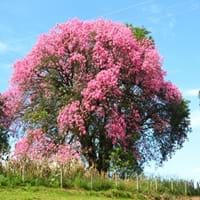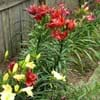Life Span
Perennial
Perennial
Type
Bulb or Corm or Tuber
Tree
Origin
Hybrid origin, North America, Europe, Africa, Asia
South America, Argentina, Brazil
Types
White lily, orange lily, Lily of the valley
Not Available
Habitat
Not Available
Subtropical climates, Tropical regions
USDA Hardiness Zone
2-8
9-15
Sunset Zone
21,22
H1, H2, 12, 13, 14, 15, 16, 17, 18, 19, 20, 21, 22, 23, 24
Habit
Upright/Erect
Oval or Rounded
Flower Color
White, Yellow, Red, Green, Purple, Gold, Pink, Rose, Peach, Burgundy, Bronze
Purple, Pink, Rose, Burgundy, Ivory
Flower Color Modifier
Bicolor
Bicolor
Fruit Color
Yellow green, Sandy Brown
Brown, Sandy Brown
Leaf Color in Spring
Green, Dark Green
Green, Light Green
Leaf Color in Summer
Light Green
Green
Leaf Color in Fall
Several shades of Green
Green
Leaf Color in Winter
Light Green
Not Available
Leaf Shape
Long Linear
Elliptic
Plant Season
Spring, Summer, Fall
Spring, Summer, Fall, Winter
Sunlight
Full Sun, Partial Sun, Partial shade
Full Sun, Partial Sun
Type of Soil
Clay, Loam, Sand
Loam, Sand
The pH of Soil
Acidic, Neutral, Alkaline
Acidic, Neutral, Alkaline
Soil Drainage
Well drained
Well drained
Bloom Time
Not Available
Late Fall, Early Winter
Tolerances
Drought
Drought, Salt
Where to Plant?
Container, Ground, Pot
Ground
How to Plant?
Seedlings
Grafting, Seedlings
Plant Maintenance
Medium
Medium
Watering Requirements
Do Not over Water
Do not water frequently, Requires a lot of watering, Requires regular watering, Water Deeply
In Summer
Lots of watering
Lots of watering
In Spring
Moderate
Moderate
In Winter
Average Water
Average Water
Soil pH
Acidic, Neutral, Alkaline
Acidic, Neutral, Alkaline
Soil Type
Clay, Loam, Sand
Loam, Sand
Soil Drainage Capacity
Well drained
Well drained
Sun Exposure
Full Sun, Partial Sun, Partial shade
Full Sun, Partial Sun
Pruning
Prune in early spring, Prune in fall, Remove dead or diseased plant parts
Remove damaged leaves, Remove dead branches, Remove dead leaves
Fertilizers
All-Purpose Liquid Fertilizer, Fertilize only when soil is poor
All-Purpose Liquid Fertilizer
Pests and Diseases
Lily Beetle
Red blotch
Plant Tolerance
Drought
Drought
Flower Petal Number
Single
Single
Foliage Texture
Not Available
Medium
Foliage Sheen
Not Available
Glossy
Attracts
Not Available
Not Available
Allergy
Not Available
Not Available
Aesthetic Uses
Beautification, Showy Purposes
Beautification, Landscape Designing, Showy Purposes
Beauty Benefits
Making cosmetics
Not Available
Environmental Uses
Not Available
Air purification
Medicinal Uses
Burns, Diuretic, Heart problems
Not Available
Part of Plant Used
Whole plant
Seeds, Stem
Other Uses
Cosmetics, Oil is used for aromatherapy, Used As Food, Used as Ornamental plant, Used for its medicinal properties
Used for producing cooking oil, Used in paper industry
Used As Indoor Plant
Yes
No
Used As Outdoor Plant
Yes
Yes
Garden Design
Alpine, Container, Cutflower, Feature Plant, Mixed Border, Wildflower
Feature Plant, Shade Trees, Tropical
Botanical Name
LILIUM
CHORISIA speciosa
Common Name
Lily
Chorisia, Floss Silk Tree, Silk Floss Tree
In Spanish
Lirio
Chorisia
In Portuguese
Lírio
Chorisia
Phylum
Tracheobionta
Magnoliophyta
Class
Liliopsida
Magnoliopsida
Family
Liliaceae
Bombacaceae
Clade
Angiosperms, Monocots
Angiosperms, Eudicots, Rosids
Tribe
Lilieae
Not Available
Subfamily
Lilioideae
Bombacoideae
Number of Species
Not Available
Importance of Lily and Chorisia
Want to have the most appropriate plant for your garden? You might want to know the importance of Lily and Chorisia. Basically, these two plants vary in many aspects. Compare Lily and Chorisia as they differ in many characteristics such as their life, care, benefits, facts, etc. Every gardener must at least have the slightest clue about the plants he wants to plant in his garden. Compare their benefits, which differ in many ways like facts and uses. The medicinal use of Lily is Burns, Diuretic and Heart problems whereas of Chorisia is Not Available. Lily has beauty benefits as follows: Making cosmetics while Chorisia has beauty benefits as follows: Making cosmetics.
Compare Facts of Lily vs Chorisia
How to choose the best garden plant for your garden depending upon its facts? Here garden plant comparison will help you to solve this query. Compare the facts of Lily vs Chorisia and know which one to choose. As garden plants have benefits and other uses, allergy is also a major drawback of plants for some people. Allergic reactions of Lily are Not Available whereas of Chorisia have Not Available respectively. Having a fruit bearing plant in your garden can be a plus point of your garden. Lily has no showy fruits and Chorisia has showy fruits. Also Lily is not flowering and Chorisia is not flowering . You can compare Lily and Chorisia facts and facts of other plants too.





